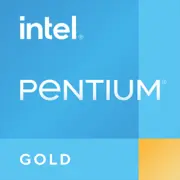Intel Pentium Gold G7400T

Intel Pentium Gold G7400T: A Budget Processor for Basic Tasks in 2025
Architecture, Performance, and Key Features of Intel's Budget Chip.
1. Key Specifications: Alder Lake in a Compact Format
The Intel Pentium Gold G7400T, released in 2022, remains a relevant budget solution in 2025 thanks to its optimized Alder Lake architecture. It is the entry-level model in the lineup, designed for low-power systems and basic tasks.
Architecture and Process Technology:
- Codename: Alder Lake-S (desktop version).
- Process technology: Intel 7 (10 nm Enhanced SuperFin).
- Cores and Threads: 2 Cores (Performance-cores) / 4 Threads — there are no hybrid Efficient-cores here.
- Frequency: Base — 3.1 GHz, no turbo boost available.
- Cache: 6 MB L3 — sufficient for light applications.
- TDP: 35 W — perfect for compact PCs and systems with passive cooling.
- Graphics: Intel UHD Graphics 710 (basic support for 4K@60Hz but weak for gaming).
Performance:
- Geekbench 6: 1529 (Single-Core), 3326 (Multi-Core).
- In real-world tasks:
- Office Applications (Excel, Word): operates smoothly without delays.
- 4K Video Playback: handles streaming content through HDMI 2.0.
- Light Gaming: Minecraft (60 FPS on low settings), CS:GO (40-50 FPS at 720p).
Key Features:
- Supports PCIe 5.0 (although it's excessive for budget builds).
- Intel Quick Sync Video — accelerates video encoding for streaming services.
2. Compatible Motherboards: LGA 1700 Socket and Chipsets
The Pentium Gold G7400T uses the LGA 1700 socket, allowing it to be installed on motherboards with 600 and 700 series chipsets.
Recommended Chipsets:
- H610: the most affordable option (from $70). Example: ASUS Prime H610M-E.
- Limitations: no overclocking, 1 PCIe 4.0 slot, 2 DDR4 slots.
- B660: the optimal choice (from $90). Example: Gigabyte B660M DS3H.
- Pros: supports DDR4/DDR5, 2 PCIe 4.0 slots, USB 3.2 Gen2.
- H670/Z690/Z790: overkill for the Pentium, but suitable for future upgrades (e.g., if planning to install a Core i5 later).
Selection Tips:
- For savings, choose DDR4 boards — the performance difference with DDR5 in this segment is negligible.
- If you need HDMI 2.0, check the specifications — not all H610 boards support it.
3. Supported Memory: DDR4 vs DDR5
The processor is compatible with DDR4-3200 and DDR5-4800, but the choice depends on the chipset:
- H610/B660 (DDR4): cheaper, 16 GB DDR4-3200 costs around $45.
- B660/Z690 (DDR5): more expensive (16 GB DDR5-4800 — from $70), with performance gains in gaming of up to 5-7%, but it’s pointless for office tasks.
Recommendation:
For a build based on the G7400T, choose DDR4 — this saves $25-30 with no loss in performance.
4. Power Supply: Power Calculation
With a TDP of 35 W, the processor is extremely undemanding on power.
Configuration Examples:
- Office PC (without a discrete graphics card):
- Power supply of 300-400 W (e.g., EVGA 400 N1, $35).
- Multimedia System (with GPU like GTX 1650):
- PSU of 450-500 W (Be Quiet! System Power 10, $55).
Important:
Even when installing a graphics card, the Pentium G7400T will not become a "bottleneck" in power consumption — it’s essential that the PSU is certified 80+ Bronze.
5. Pros and Cons
Pros:
- Energy Efficiency: suitable for mini-PCs and systems with passive cooling.
- Low Price: in 2025, the processor costs $80-90 (new).
- Integrated Graphics: UHD 710 handles basic tasks well.
Cons:
- 2 Cores: multi-threaded applications (e.g., video editing in DaVinci Resolve) may lag.
- Weak Upgrade Path: while you can install Core i3/i5 on the LGA 1700 socket, it’s often more cost-effective to buy them instead.
6. Use Cases
- Office PCs: ideal for working with documents and browsers (10-15 tabs).
- Home Theater: 4K HDR via HDMI, streaming services (Netflix, YouTube).
- Light Gaming: indie projects (Hollow Knight, Stardew Valley), older AAA titles (Skyrim, GTA V on low settings).
- Educational Systems: suitable for schools or offices where high performance is not required.
Real Example:
A Reddit user built a mini-PC on the G7400T in an ASRock DeskMini case (total cost of $300). The system is used as a media center and for work in Google Docs.
7. Comparison with Competitors
AMD Ryzen 3 5300G (Price: $100-120):
- Pros: 4 cores / 8 threads, Vega 6 (1080p gaming at medium settings).
- Cons: more expensive, higher TDP (65 W).
Intel Core i3-12100T ($120-130):
- Pros: 4 cores / 8 threads, UHD 730.
- Cons: 30-40% more expensive with similar graphics.
Conclusion: The Pentium G7400T excels only in price and energy efficiency. If the budget is tight, it’s a viable option. If multi-threading is required, it's better to spend an additional $20-30 for the Ryzen 3.
8. Assembly Tips
- Motherboard: Gigabyte B660M DS3H AX (DDR4, Wi-Fi, $110).
- Memory: 16 GB DDR4-3200 (TeamGroup Vulcan Z, $45).
- Storage: Kingston NV2 500 GB (PCIe 4.0, $35).
- Case: Cooler Master MasterBox Q300L (compact, $60).
Cooling:
The standard boxed cooler will suffice — even under load, temperatures do not exceed 65°C.
9. Final Conclusion: Who is the G7400T Suitable For?
This processor is a great choice for those who:
- Are building a cheap office PC (total build cost from $250).
- Need a quiet system for a media center.
- Are looking to upgrade an old PC with a Pentium G4560 (if a compatible motherboard is available).
Why You Shouldn't Buy:
If you plan on gaming, video editing, or working with "heavy" applications — even the Ryzen 3 5300G will perform significantly better.
Price Guidelines for March 2025:
- Processor: $85.
- Motherboard: $70-120.
- "Office + Multimedia" Build: $250-350.
The Pentium Gold G7400T is not the most powerful, but it's one of the most affordable processors for non-demanding tasks. Its main advantage is the balance of price and energy efficiency.
Basic
CPU Specifications
Memory Specifications
GPU Specifications
Miscellaneous
Benchmarks
Compared to Other CPU
Share in social media
Or Link To Us
<a href="https://cputronic.com/cpu/intel-pentium-gold-g7400t" target="_blank">Intel Pentium Gold G7400T</a>